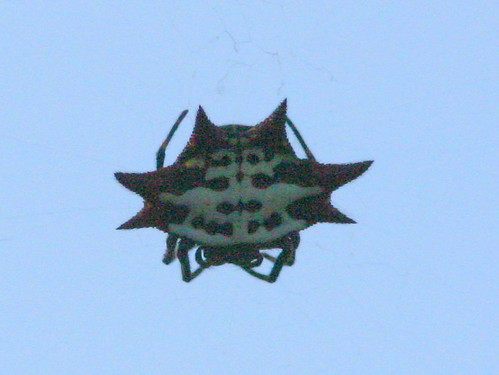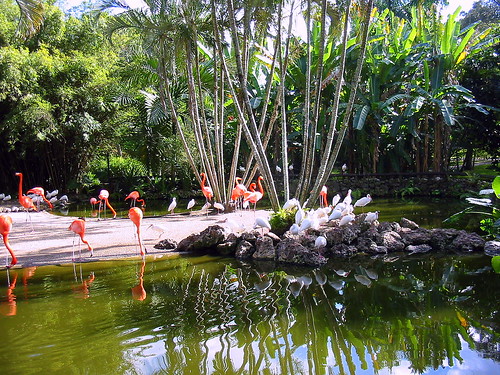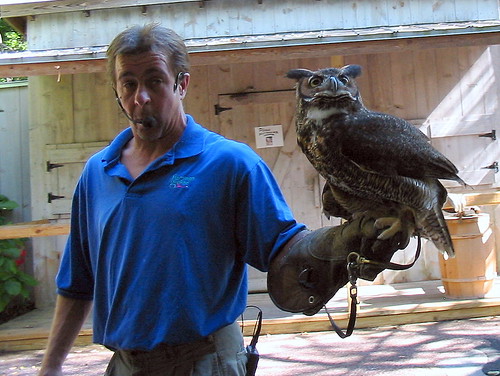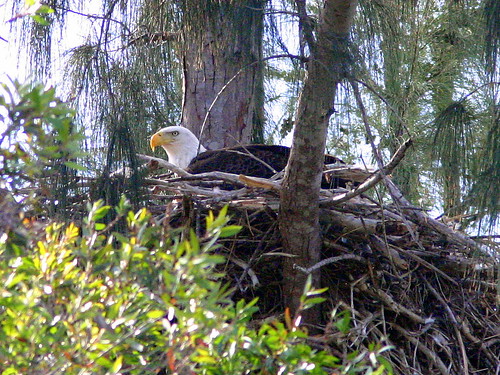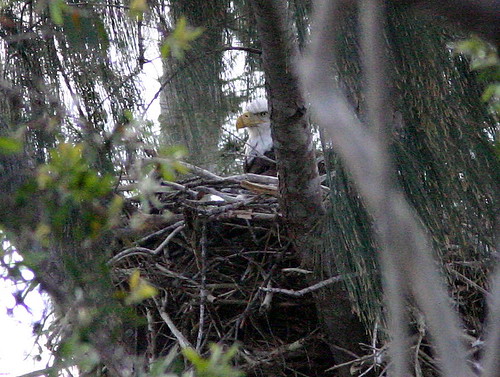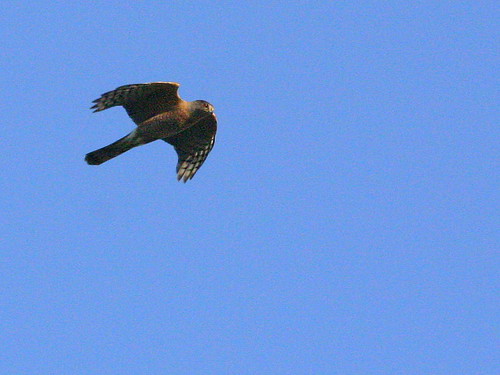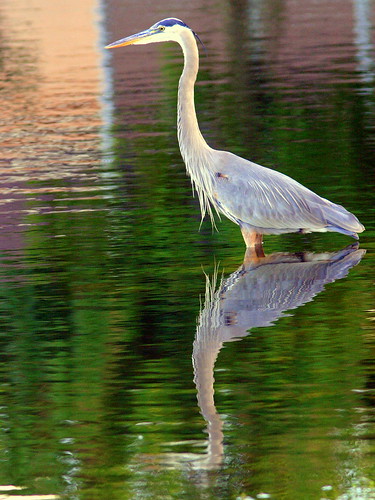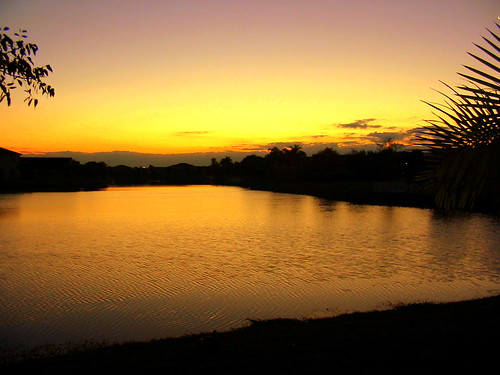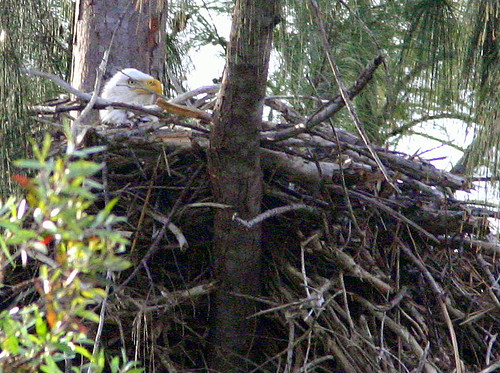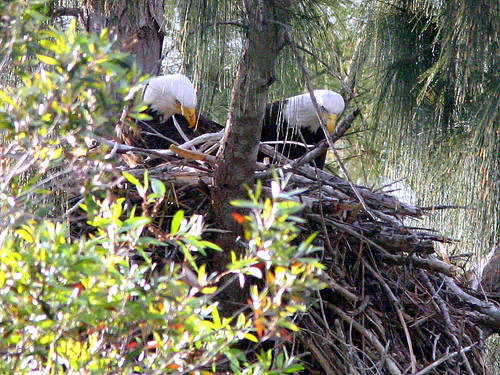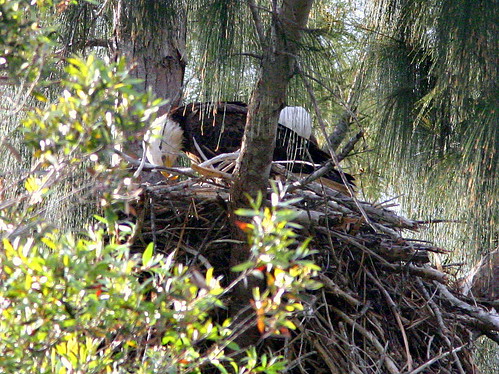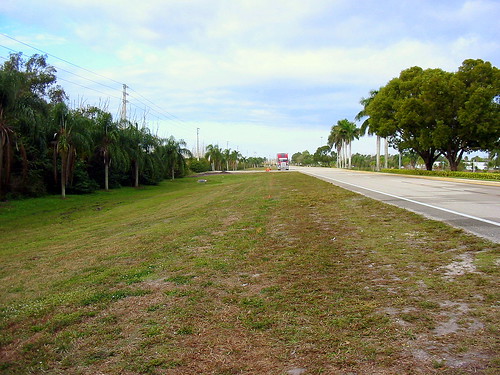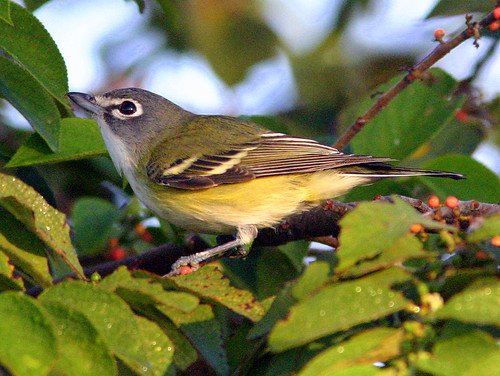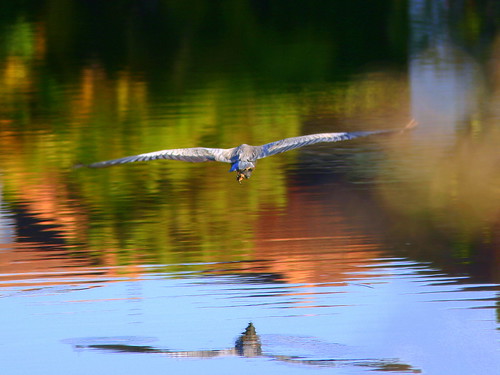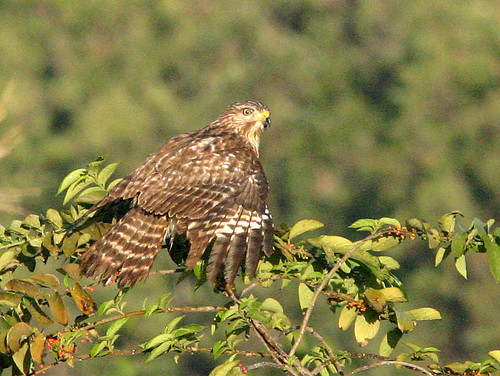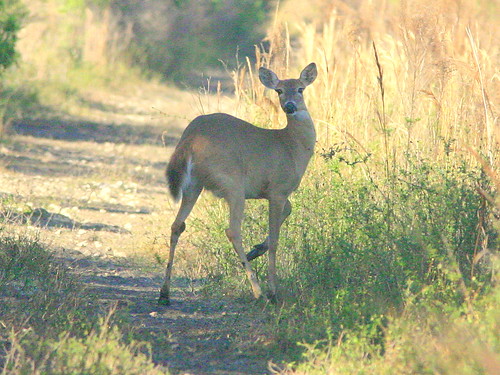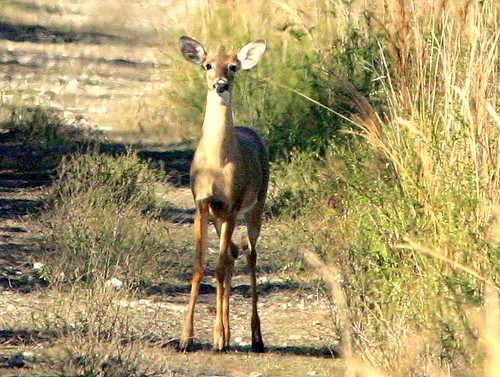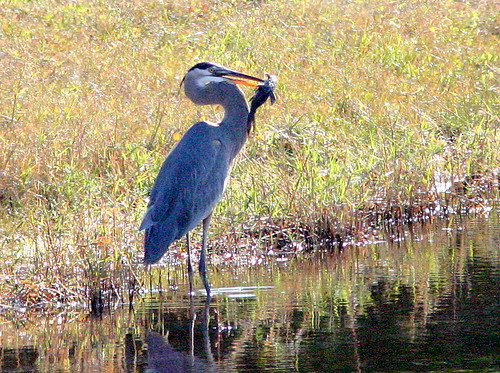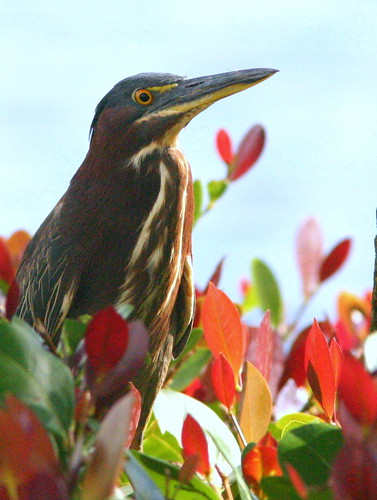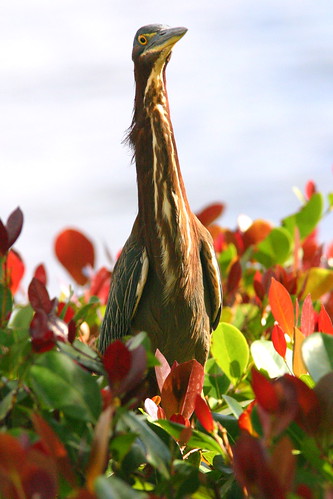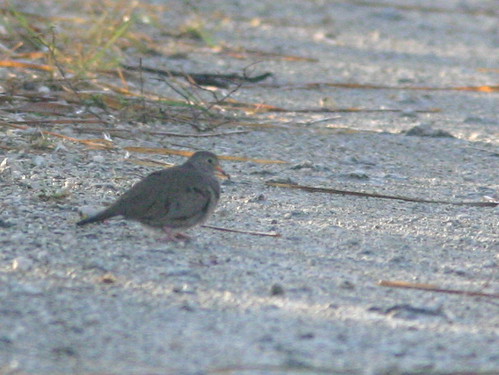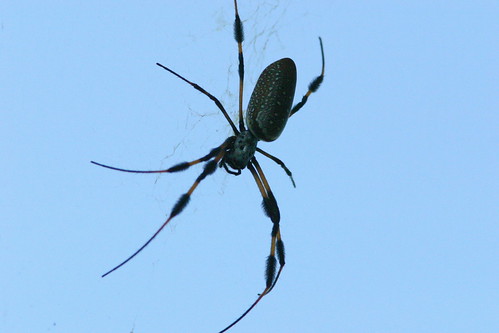On January 26, I accompanied a group of 7th grade science students on a field trip to Flamingo Gardens, a private arboretum, preserve and wildlife rehabilitation facility in Davie, Florida. These students are studying the effects of traffic on the behaviour of the Bald Eagles nesting only about 200 feet from a busy boulevard. They designed forms, upon which they record traffic density and check off the various actions of the birds, whether one or both of the adults are present at the nest, their vocalizations, and any indications of nervousness or avoidance.
Greater Flamingos and White Ibises make a pretty picture, even with my old 2 megapixel point-and-shoot:
A curator exhibited a Great Horned Owl with a broken wing that was beyond repair:
Other obligations (including much correspondence with Florida officials about our concerns for the safety of the nest because of the planned construction) have kept me from going afield for the past few days, but I hope to get out to see our neighborhood Bald Eagle nest tomorrow. For an update on the status of the planned construction, visit this link. I last visited the nest on Tuesday, January 27th, when the first chick was 11 days old.
The female was sitting quite high in the nest. Perhaps this is an indication that a second chick has hatched and the eagle does not have a third egg to incubate:
While watching the nest I saw movement through the sticks that make up the nest cup. Several times. a spot of white appeared and then disappeared, just a few inches away from the adult bird, which often looked down into the nest. I assumed the spot of white was the down of an eaglet’s head.
Here is a photo showing what I believed to be the rounded head of a chick, with the left half partly in shade (click on the photo and select the full sized view):
Moments later, the white spot disappeared, and I assumed the chick had crouched down:
Now I am not sure, as I may have things reversed. It is possible that the white area is a view of the sky, along with the right margin of the tree trunk, and actually the second photo shows the area obscured by the chick. In any event, the chick was moving about, and we are anxious to see it reaching up to be fed.
Staying at home did not deprive me of a few backyard photo opportunities. A Palm Warbler foraged on our patio, and I photographed it through the window glass:
This Cooper’s Hawk flew right over my head, but I still have troubles focusing on moving targets, and my full-screen image was just a blur. Here are a couple from farther out, when I had time to focus (click on photo to see the other image):
A Great Blue Heron was cooperative as it fished in thigh-deep water just off our back lawn:
Sunrise from our patio:
A row of orange utility markers signal that construction is soon to take place, only 200 feet from the nest of a Bald Eagle nest containing a newly hatched chick:
I have spent a frustrating, but educational, couple of days, learning about how poorly various levels of government communicate with each other. For those who don’t know, we have a Bald Eagle nest in our neighborhood, only about 215 feet from the edge of a busy boulevard. They are the first pair known to have established an active nest in Broward County since DDT was abolished in the 1970s. View our Eagle Nest Page for the history of this nest.
I watched for an hour this morning between 9 and 10 AM, but this was the best view of the bird I could obtain: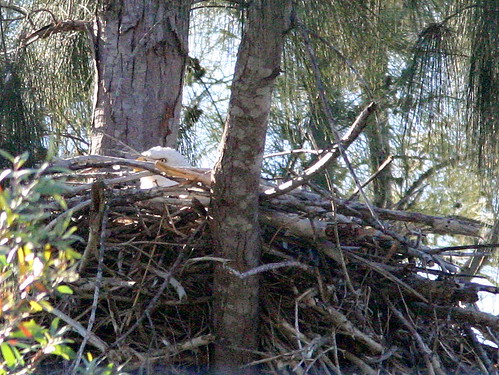
Florida’s Bald Eagles have made an amazing recovery. There are now over 1200 pairs nesting in the Sunshine State, up from 88 pairs in 1973, and an estimated 417 in all the lower 48 states back in 1963. Population pressures, combined with relentless “reclamation” and development of their natural habitat is now pressuring them to seek nesting sites away from their traditional haunts in the Everglades, swamps and pine forests. Increasingly, this brings their needs into conflict with ours.
The local birds successfully raised one chick last season, despite being adjacent to two housing developments and besieged by the noise and hubbub of rush-hour traffic, a nearby construction staging area, and even a police shooting range within earshot (no pun intended). These brave invaders of our urban space lead us to question the conventional knowledge that they need the seclusion of wild places to insulate them from contact with the greatest historical threat to their health and safety: humans.
According to the US Census Bureau, 50% of us live in the suburbs, and 30% in cities, taking up 5% of the total land area of the US. The suburbs are undergoing the greatest rate of expansion.
Wild things, and particularly birds, have three choices as humans invade their historical territory. The meek, the Avoiders,* fade back into their ever-shrinking natural habitats, where paved roads are scarce. As natural areas are fragmented and degraded, these species face the greatest threat of extinction. Think Spotted Owl and Red-cockaded Woodpecker.
The second choice is for species to adapt to those areas that are paved over, with anywhere from 20% to 50% of the land covered by homes, offices, parking lots and roads. These Adapters* choose places on the edge of suburbia, or large city parks or preserves, the last remnants of their familiar habitats. Find the robins, Kestrels, Mourning Doves and Red-tails at the local overgrown cemetery.
Finally, we all know the birds that not only invade, but relish the urban environment, where buses spew fumes and commuting workers’ heels click on the sidewalks. We love these Exploiters*, the pigeons, House Sparrows, grackles, starlings, and in Florida, the Muscovy Ducks, Monk Parakeets, and even White Ibises. For the shut-in city kids, they offer a glimpse of another, freer world. Some of these birds are so well adapted to, and dependent upon, city life that they are rarely found away from civilization.
Our local Bald eagle pair, under population pressure as their natural habitat diminishes, has chosen the second path to success. Whether it was a wise choice is yet to be seen. Others of their kind have been even more adventurous, finding nesting sites on cell phone towers and utility poles. In any event we now face one of the inevitable conflicts that arise when our interests conflict with those of our National Symbol.
These urbanized eagles defy science, a science born deep in Alaskan fjords, Minnesota lakes, and mangrove islands. Credible studies showed how human incursions within a perimeter of 200 meters (660 feet) resulted in a significant risk of nest failure. Although the Bald Eagle has been removed from the Endangered Species List, it continues to be federally protected under the Bald and Golden Eagle Protection Act and the Migratory Bird Treaty Act.
At the State level, the Florida Bald Eagle Rule is very similar to the Federal Bald and Golden Eagle Protection Act, in recommending the types of activity that should occur near the nest during breeding season. If there is “similar activity” closer than 1 mile from the nest, and the activity will be visible from the nest, additional such activity should take place “no nearer than 660 feet, or as close as existing tolerated activity of similar scope.” The Pembroke Pines eagles are already tolerating vehicle and pedestrian traffic along the south shoulder of Pines Boulevard. If the planned construction involves mechanized excavation, it will exceed “existing tolerated activity,” and would, if it were more than 330 feet from the excavation, require a permit from the Florida Fish and Wildlife Conservation Commission (FWC). However, the FWC cannot issue a permit if the disturbance is nearer than 330 feet– it may only advise that the construction not be carried out until the eaglets have left the nest! Therefore, there is no formal involvement of FWC in negotiating and monitoring the work that is carried out, to assure that there is less risk of nest abandonment, or death of the chicks.
It took all of yesterday for the City, after searching its own permit records, to finally find out that the work is to be done by the Broward County Traffic Engineering Division. [ADDENDUM: more recently, the County has advised us that the work is actually being done by a contractor for the Broward County School Board, under a license from the Florida Department of Transportation.] Such work requires a permit from the FWC. Now they know about the problem, and we hope the FWC will be able to do its job and enforce its rules.
This (still unfolding– see my discussion of the urban “donut hole in Bald Eagle protection) episode is more a reflection of the reality that coordination between the various levels of government is extremely difficult, and requires ongoing efforts and resources. The utilities that were marked, and the planned construction are all within a utility easement. Apparently, the County is not required to seek a permit from either the City or from the State DOT [however, the Broward County School Board did obtain a permit from DOT, although neither were aware of the eagle nest until we brought it to their attention], who share jurisdiction. If there is no permit, there is no “red flag” in the construction process whereby the contractor, who does the work for the responsible agency, is ever informed that there is a FWC-registered eagle nest anywhere in the vicinity. Just who is responsible for the information gap? The State FWC? The State DOT? Broward County? The Contractor? The City?
The answer is either none of the above, or all of them, as that is the way the system works. Now I am very glad that, at least, some local citizens are informed and educated. That is why I “went public” about the existence of the nest in the first place, despite cautions that such information must be kept as a guarded secret. I just did not have confidence in “The System,” because there is no system. The people of Pembroke Pines obviously value their natural places, as evidenced by their many and beautiful preserves and nature centers, so I had confidence in them.
Footnote:
* as Michael McKinney calls them in his essay, Urbanization, Biodiversity, and Conservation, in the October, 2002 issue of BioScience.
We visited our local Bald Eagle nest this morning. Since the first egg was laid on or about December 13, 2008, we expected it to hatch on or about yesterday, January 17, 2009. Signs that an egg has hatched might include any change in behavior. Also, after an eaglet hatches, the incubating adult must continue to incubate any remaining egg(s), while sheltering the new arrival, and do this without crushing or smothering the helpless baby. Therefore, the parent will tend to stand up higher in the nest.
8:15 AM: Single adult is incubating. It appears restless, changing its position several times. Up until now, the incubating bird sat far down , usually nearly out of sight in the nest cup, and it stayed in the same position for about about 20 minutes before shifting around and possibly re-positioning the eggs:
8:40 AM: After about a half hour, its mate appeared. There was about a minute of excited chirping between them, which may not be unusual. We expected them to exchange incubation duties as has been observed several times in the past:
8:45 AM: Instead of exchanging incubation duties, the pair just stood together, peering down into the nest:
8:50 AM: The bird that had been incubating did not depart. Instead, it seemed to be picking at something hidden within the nest cup. After the two had been together for about ten minutes, the other bird flew off without displacing the incubating bird. This behavior suggests that one of the eggs has hatched since yesterday:
Much has transpired since my last note. On the evening of January 16th, Kelly Smith noted that flags marking underground utilities had been placed along Pines Boulevard the entire length of the block, right in front of the “Eagle Forest.” This usually means that some kind of construction is imminent. Since this is a long weekend, we may not be able to find out until tomorrow exactly what is planned. Since the flags are only about 200 feet from the nest, and the chicks will be especially vulnerable to disturbance at this time, we are alarmed and will ask the City of Pembroke Pines to defer any non-emergency construction until after the end of the breeding season, which should be around early May. Follow the eagles and the Middle School student research project at this link.
Orange utility locator flags are barely visible in the grass, about 8 feet in from the road pavement:
Posted by: Ken @ 10:11 pm
This Prairie Warbler, at nearby Chapel Trail Nature Center in Pembroke Pines, provided us with some delightful views: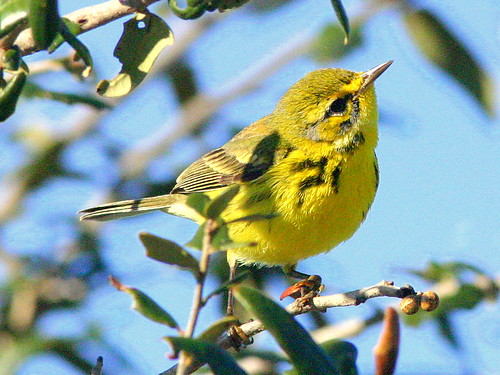
If you have read my journals before, you know that I do most of my birding locally. Although field trips and seeing new and exotic species is enjoyable, I have discovered that covering the West Miramar ESL (Environmentally Sensitive Land) has its own rewards. This local patch of recovering Everglades is within easy walking distance from our home, and almost every visit provides a humble surprise.
This morning dawned cool and windless, promising ideal photography, if I could find suitable subjects. Sure enough, after walking the quarter mile on the gravel road, we turned into the first wooded area.
To our surprise, a beautiful Blue-headed Vireo flew up to the top of a tree right in front of us. It disappeared almost as quickly, and I only had time to click the shutter three times. The third view was a “butt shot” as it made its exit.
I did not expect the other photos to be very good, but, after downloading the images at home, was pleased at what I had captured:
The surface of the lake was unusually still, and this Great Blue Heron escaped before I could get a good portrait, but it accented the beauty of the water and vegetation as it flew northward with the light behind it:
Then, on the way to the wetlands another quarter of a mile along the levee that borders the ESL, we encountered one of my favorite LBJs (Little Brown Jobs), an Eastern Phoebe. This bird proves that brown is beautiful!
The phoebe’s muted pastels fit so nicely with its habitat:
This first-year Red-shouldered Hawk is molting. At first, I mis-identified it as a Red-tailed Hawk, as it appeared quite bulky, and immature Red-tails can have light “windows” near their wing tips, but I have never seen white ones. Vince Lucas pointed out how white the windows are, and now I also see that its head and beak do not look like the Red-tail’s.
Note how its four new outer primary feathers contrast with the other six worn primaries and its frizzy old tail feathers:
Another view shows a reddish cast to the plumage, and the smaller bill and head that support Vince’s conclusion: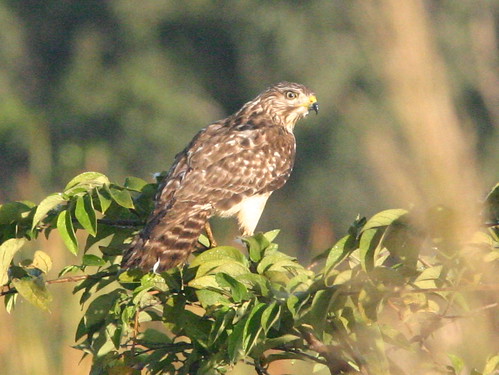
A Loggerhead Shrike was on duty, monitoring our every move:
After entering the shaded path that leads into the heart of the wetlands, I heard breaking branches to my left, and a large doe suddenly appeared just ahead of me, stared my way for a while, then bolted away.
While deer are very common in many places, it was a treat to see one so near our home:
Moments later, a spike buck emerged from the brush and took several steps towards me before realizing the potential danger:
Then, as I approached the bank of the small canal that runs along the path, a Cottonmouth slithered down from the opposite side, and angled across the stream towards me, getting within about 10 feet of my position. Though not considered aggressive, its venom is particularly potent.
Note how this poisonous moccasin characteristically swims on the surface of the water, its head held high. Non-poisonous water snakes usually duck underwater and flee:
On the way out, a Great Blue Heron (maybe the same one seen earlier) was struggling to swallow quite a large fish. It seemed to lodge in its lower esophagus. Even after getting it down, the bird kept drinking water and splashing with its beak.
Click on the image to see the full sequence of photos:
Last evening, a Green Heron was sitting atop the cocoplum hedge off our back patio, hunting anoles. It probably was the same one who got all “huffy puffy”
I had taken the colors of the cocoplum’s new red shoots quite for granted, until I viewed my photos. The afternoon sun gave them and the bird a luminescent quality.
Alarmed, the Green Heron suddenly extended its snakelike neck, but held its place and resumed its hunt after I walked back into the house:
Yesterday morning, I saw a Bobcat again, at nearly the same spot as the smaller one that I photographed the day before yesterday. I had been on a side trail, photographing gnatcatchers and walked back to the main trail. There, only about 50 feet away, the cat was staring at me intently. When I reached for my camera it was gone in an instant. Its bulk was about twice that of a tomcat, with longer legs. I believe it had been stalking a Common Ground-Dove, which was frozen in one spot for several seconds, only about 10 feet from where the Bobcat stood .
Instead of another Bobcat photo, I got this one of the dove:
I wasted many megapixels, trying to catch one of several gnatcatchers in flight. A small flock was actively feeding, dashing here and there, and hover-gleaning insects and spiders in a clump of shrubby trees.
Of about 20 photos (mostly of leaves and branches with an occasional gray blur), this is the only one that showed a recognizable Blue-gray Gnatcatcher: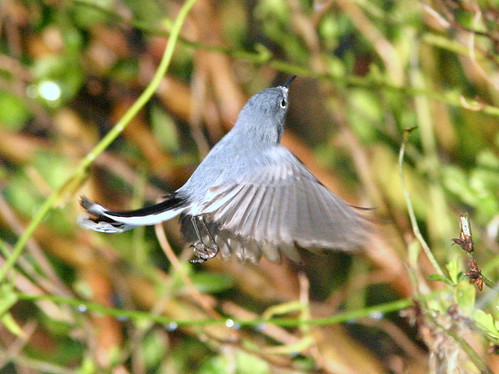
On Sunday morning, we briefly visited Hugh Taylor Birch State Park, next to the beach in Fort Lauderdale. Despite its urban location, it is a remarkably quiet oasis of dry hammocks, mangrove thickets and lagoons. We saw several Red-shouldered Hawks, striking their usual graceful pose, looking almost shy as they seemingly averted their gaze.
This Red-shouldered Hawk gave us wonderful views:
I’m still trying for a drop-dead picture of a Red-bellied Woodpecker.
This one kept far away, so its image is heavily cropped:
A Tricolored Heron struck a stately pose in a lagoon: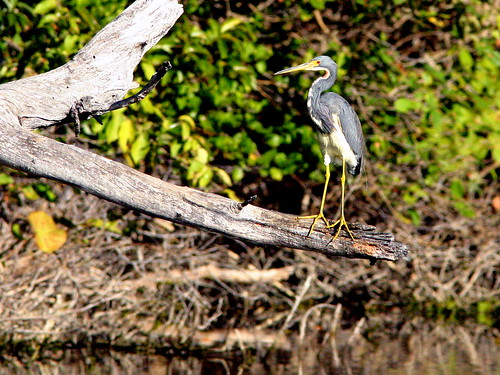
This huge Golden Silk Orb Weaver had spun its web next to the trail:
The Spiny-backed Orb Weaver is very unusual, at least to any new Floridian: